Learn the best DIY tips to fix your headphone or earphone wires at home with this simple step-by-step guide.
Headphone wires are one of the most fragile parts of any headphones, yet they’re also the most overlooked. As a result, they’re often the first to become damaged.
With every yank, twist, and turn, the wires’ outer rubber insulation becomes weaker and thinner. Eventually, your headphone wires become more exposed, causing them to fray or be torn off entirely. What’s worse is that even if you handle them carefully, your headphone wires are still prone to other accidents, such as getting chewed up by your pets.
But don’t worry! If you’re dealing with damaged headphone wires, you don’t have to throw them away just yet!
There are several easy DIY fixes you can do at home to fix broken or fraying headphone wires without using soldering tools. You’ll also find tips on how to patch up more severely damaged headphone and earphone wiring, including replacement options for lost causes. So, let’s get into it!
Are Exposed Headphone Wires Dangerous?
No. Exposed headphone wires are generally not dangerous.
Although electricity does pass through headphone or earphone wiring, it does so at a very low voltage that’s dependent on the headphones’ impedance. So, even if you accidentally touch an exposed wire, you can rest easy knowing that your headphones’ frayed wiring won’t electrocute you.
However, while exposed headphone wires aren’t exactly hazardous when touched, your audio device may not be as safe as you think it is.
Exposed headphone wires are more likely to damage the headphones by short-circuiting. Short circuits happen when excessive charge flows to an unintended wire and often occur when the wire insulation is worn out or exposed. This can cause overheating and electrical sparks, damaging both your headphones and audio source.
How to Fix Headphone Wires That Are Beginning to Fray
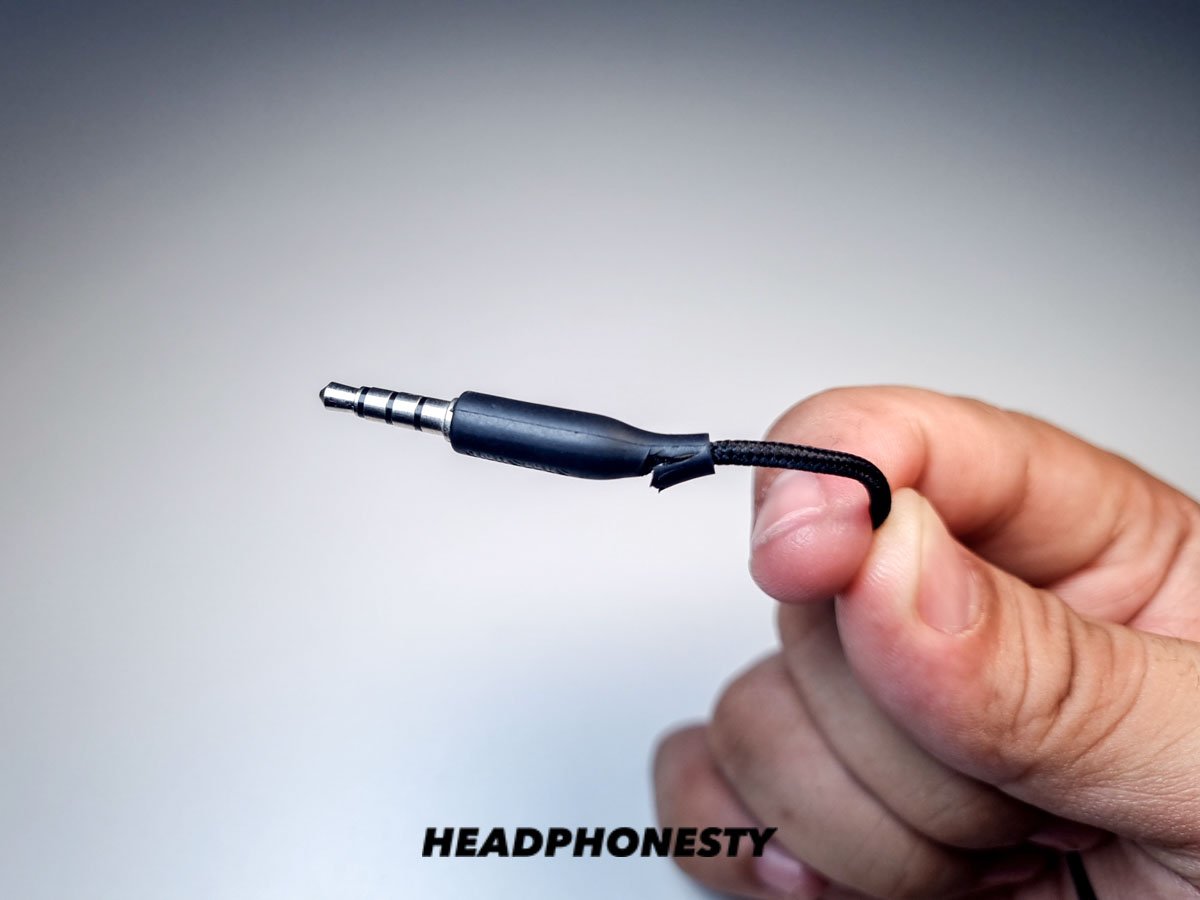
When it comes to headphone or earphone cables, the part closest to the plug is often the first to show signs of fraying. Most of the time, it’s because of the frequent abuse this area receives.
We often latch onto this part when yanking or tugging the headphone cable out before putting it away. It’s also the part we tend to twist, push, or bend when the headphone jack doesn’t stay in place.
This repetitive damage eventually takes its toll on the headphone wiring and results in common issues such as hearing static sounds or having only one working speaker.
Fortunately, there are quick fixes for fraying or exposed wires that require little money and effort. Here are four easy ways to repair headphone and earphone wires at home:
- Wrap it with electrical tape
- Use heat-shrink tubing
- Mould Sugru around it
- Use cable savers
Wrap it with electrical tape
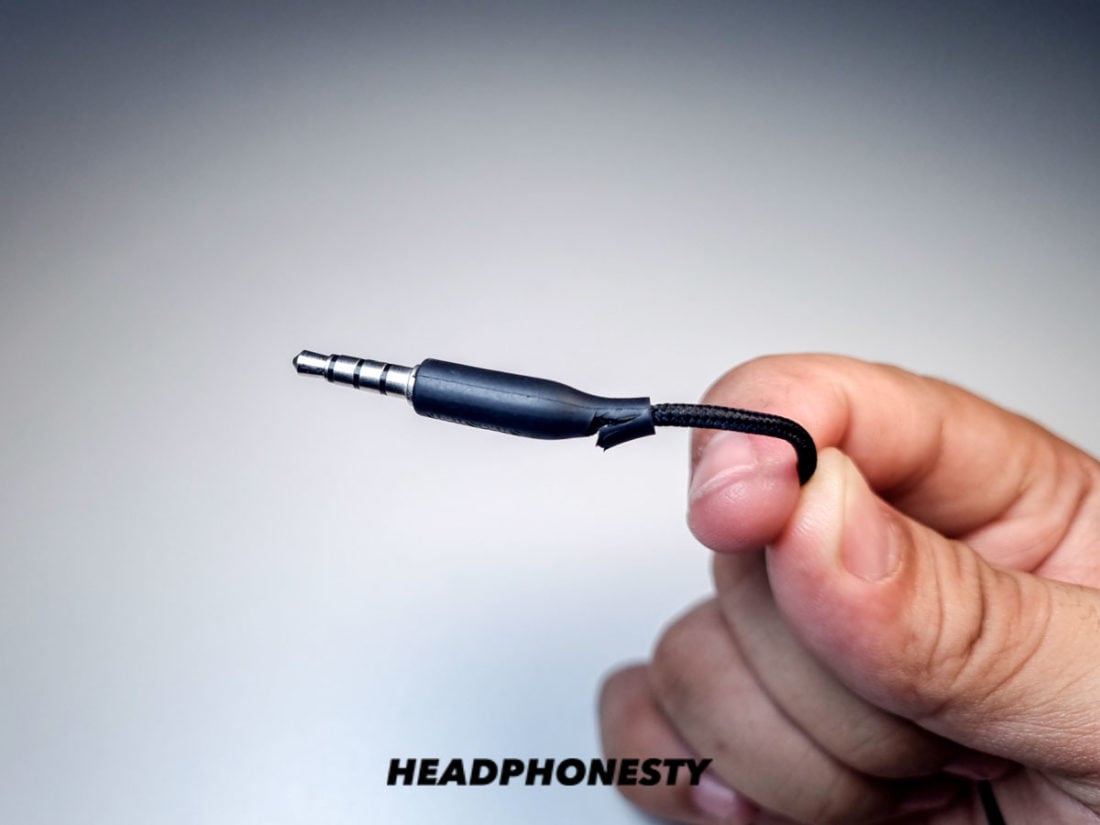
Most people have electrical tape in their homes, and if not, they’re easy to buy from any hardware store. Electrical tape is designed to insulate electrical wires. Black colored electrical tape, in particular, is made for low voltage electrical wires, so you can try using it for a quick and easy headphone wire repair.
Follow these fail-proof steps:
- Prep your wire. Before anything else, make sure that your headphone wires are clean and have no traces of oil on them. This ensures the electrical tape will stick to the wire longer and more securely. You can do this by taking a clean cloth with a small amount of isopropyl alcohol and wiping the area down.
- Pre-cut your electrical tape. Electrical tapes vary in size. Pre-cut your electrical tape to your desired size before wrapping it around the wire.
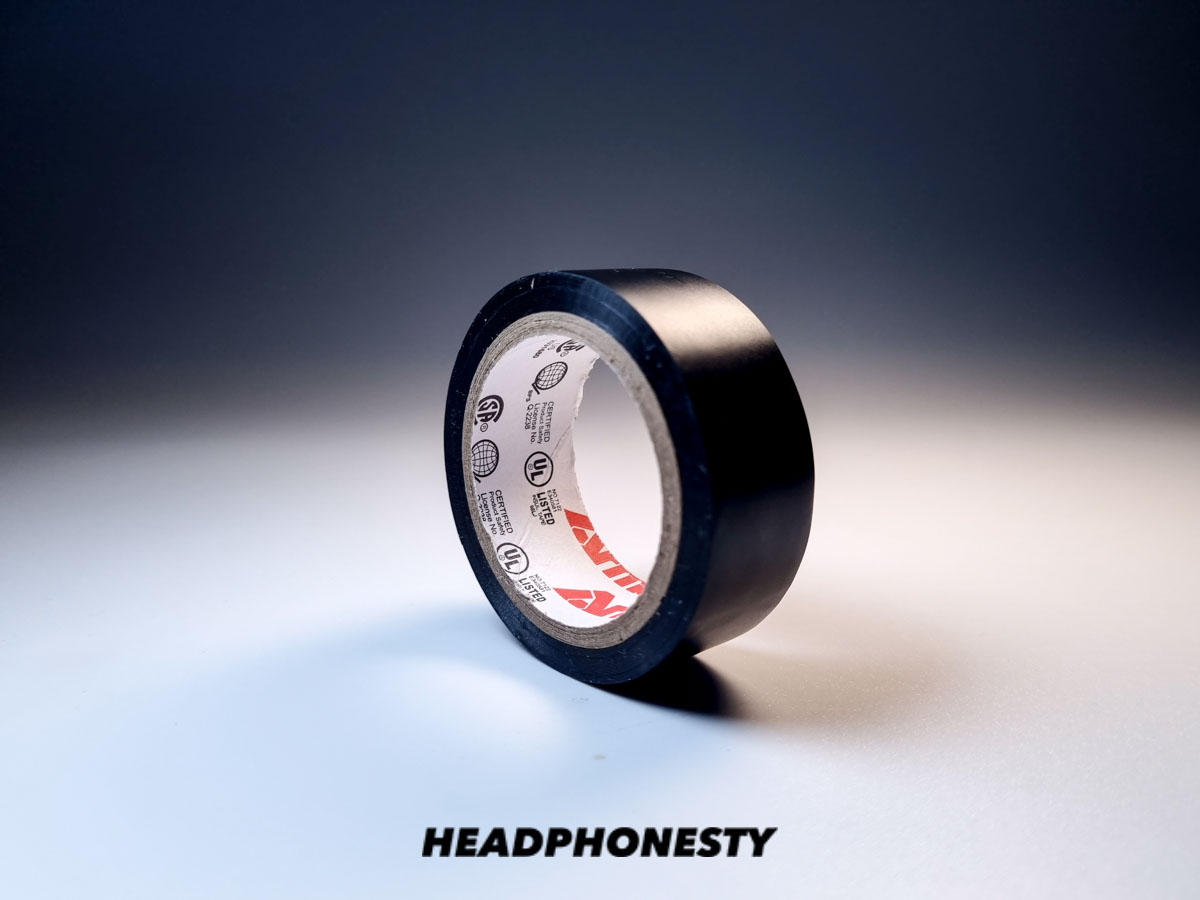
Place tape on the damaged area - Wrap it. Wrap the electrical tape around the wire as tight as possible. This will protect the wire from fraying further and insulate it.
Use heat-shrink tubing
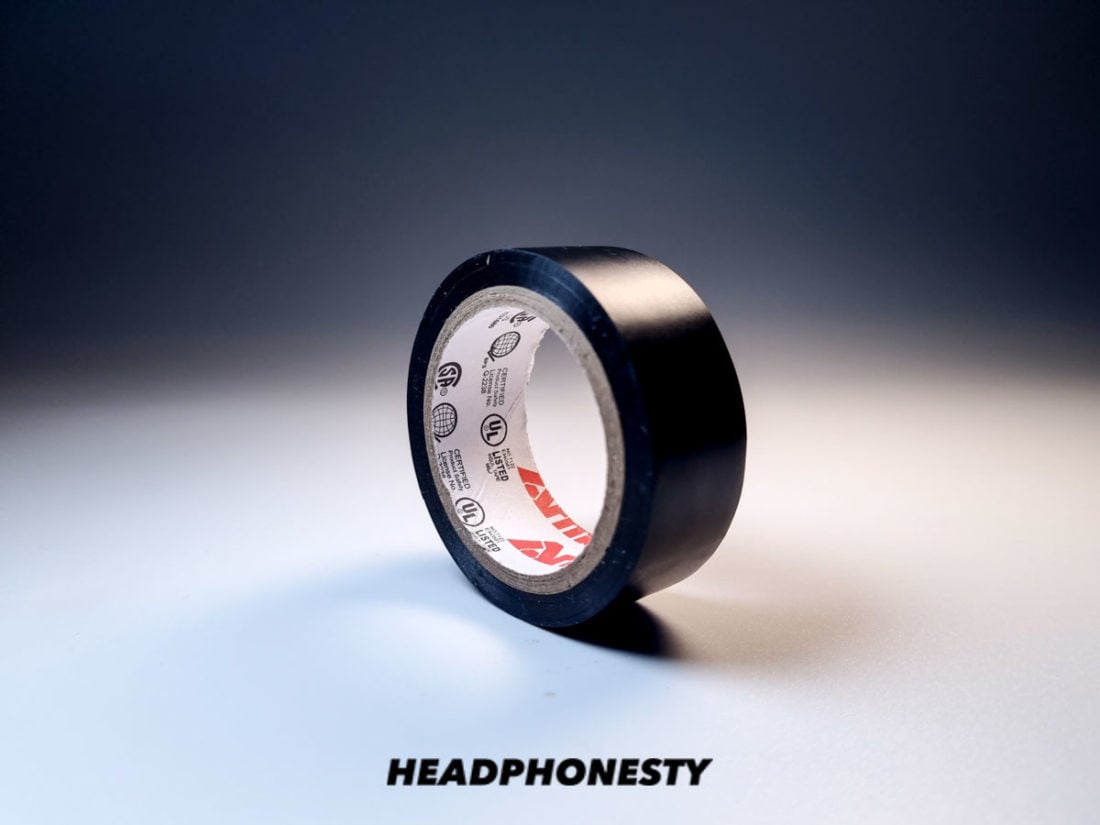
You may also try using heat-shrink tubings or sleeves for a more durable and long-lasting fix. These tubings are primarily used for repairing, reinforcing, and insulating frayed electrical wires.
Here are the steps on how to use them:
- Check the material. Heat-shrink tubings are usually made from plastic materials such as polyolefin, FEP, or PVCs.
- Choose the right size. Choose a heat-shrink tubing that perfectly matches your headphones’ cable size for a snug, secure fit. Depending on their material and composition, these tubings can contract one-half to one-sixth of their original diameter when heated. Popular shrink ratios (the ratio between the tubing’s original size and its shrink size) are 2:1, 3:1, and 4:1.
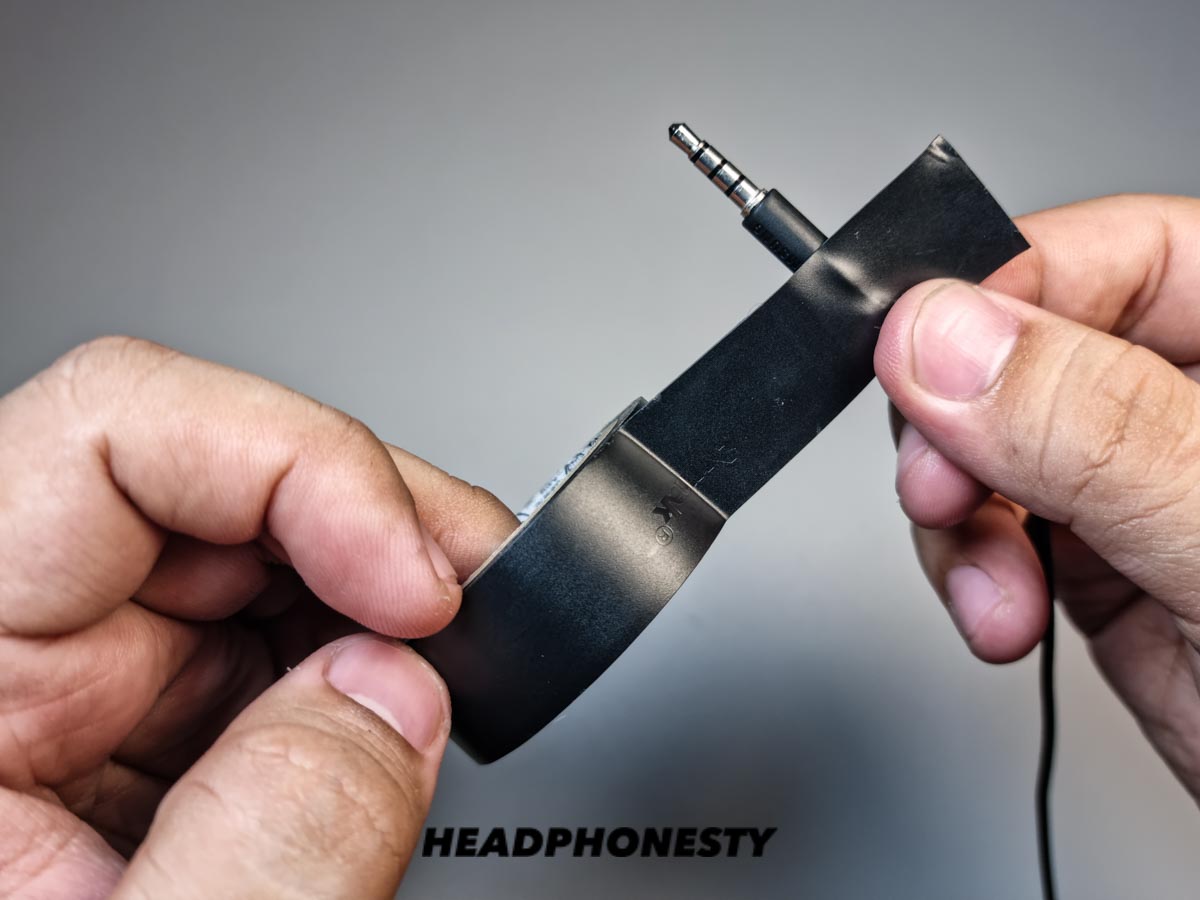
Heat shrink tubing sizes - Clean the area to be wrapped. Make sure to rid your headphone wires of any excess debris or grease. Take a clean cloth with a small amount of isopropyl alcohol and wipe the area.
- Insert the headphone cable through the tubing. Make sure the tubing is positioned directly over the headphones’ frayed wires. If you’re using the wrap-around heat-shrink type, make sure to wrap it as tight as possible for a more compact finish.
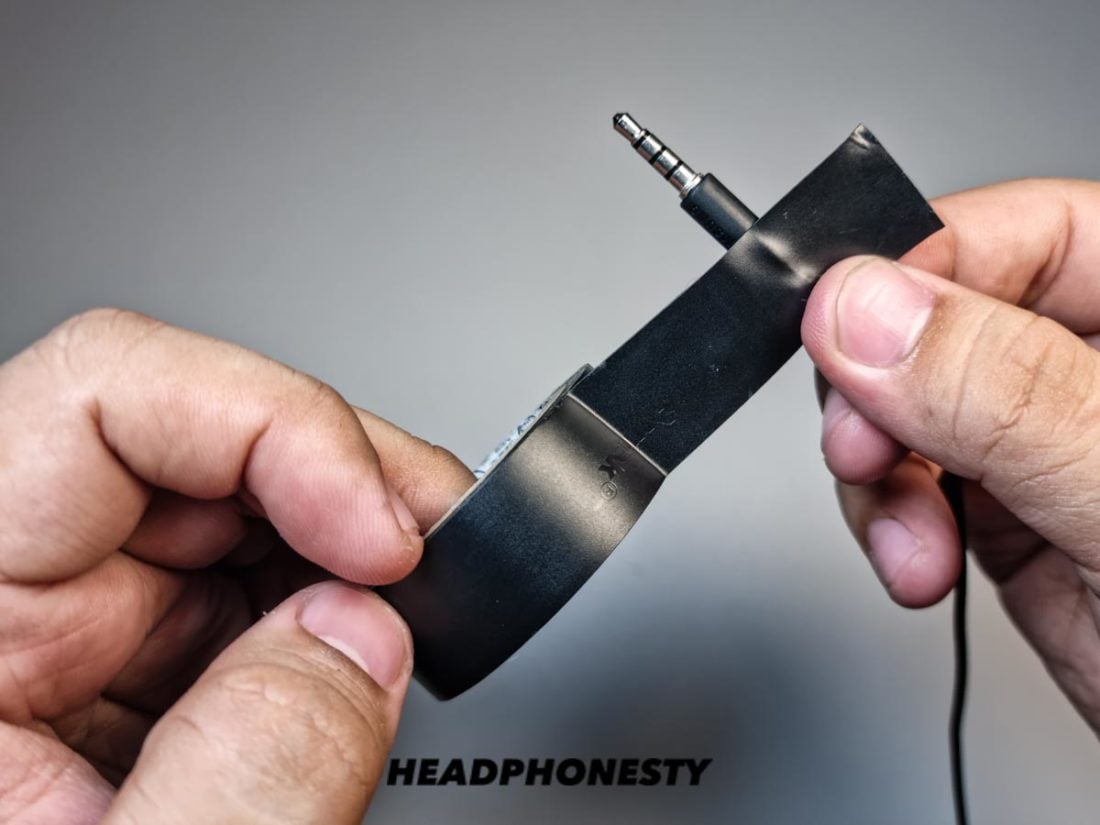
Insert the tubing on the headphone cable - Apply heat to the area. You can heat the area by using the heating device that comes with the heat-shrink tubing kit, a hot air gun, or a lighter.
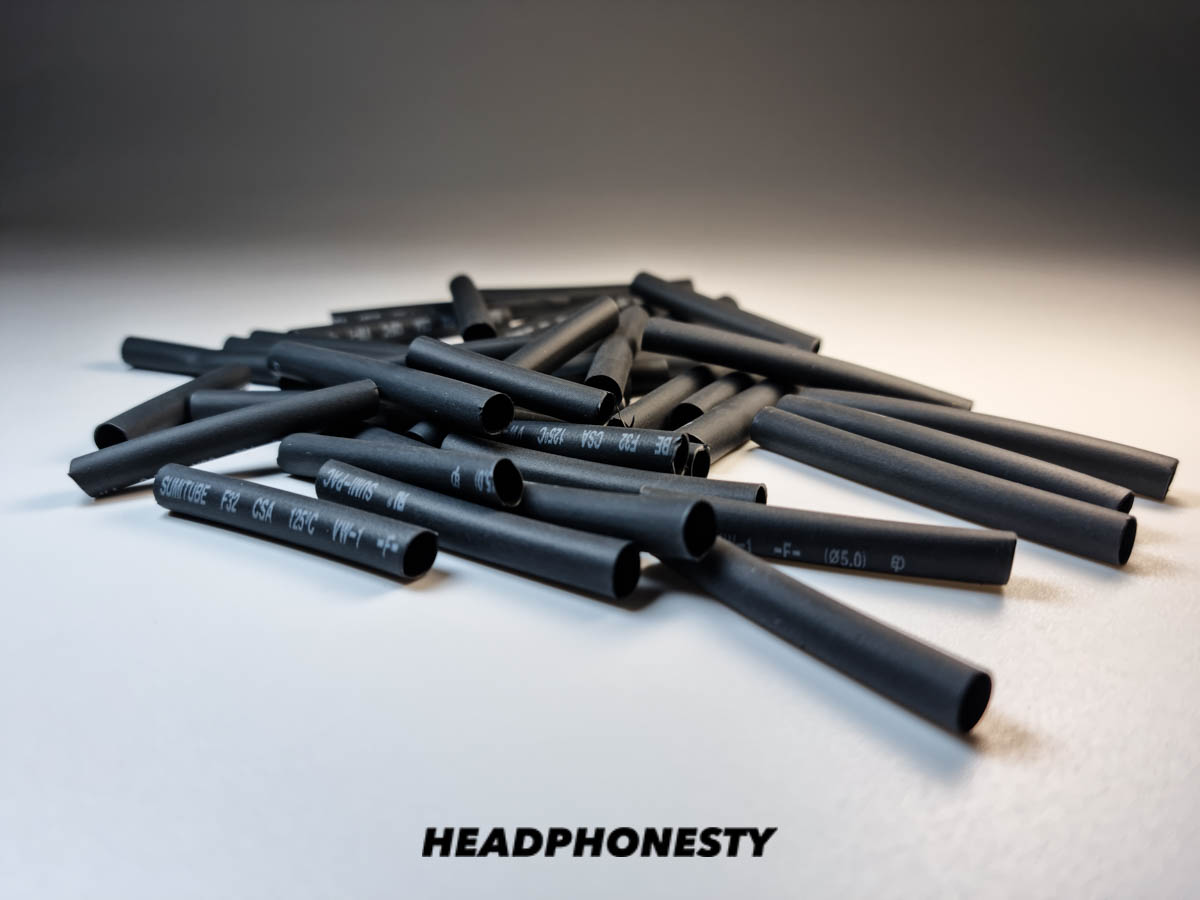
Applying heat on tubing to constrict it
Mould Sugru around it
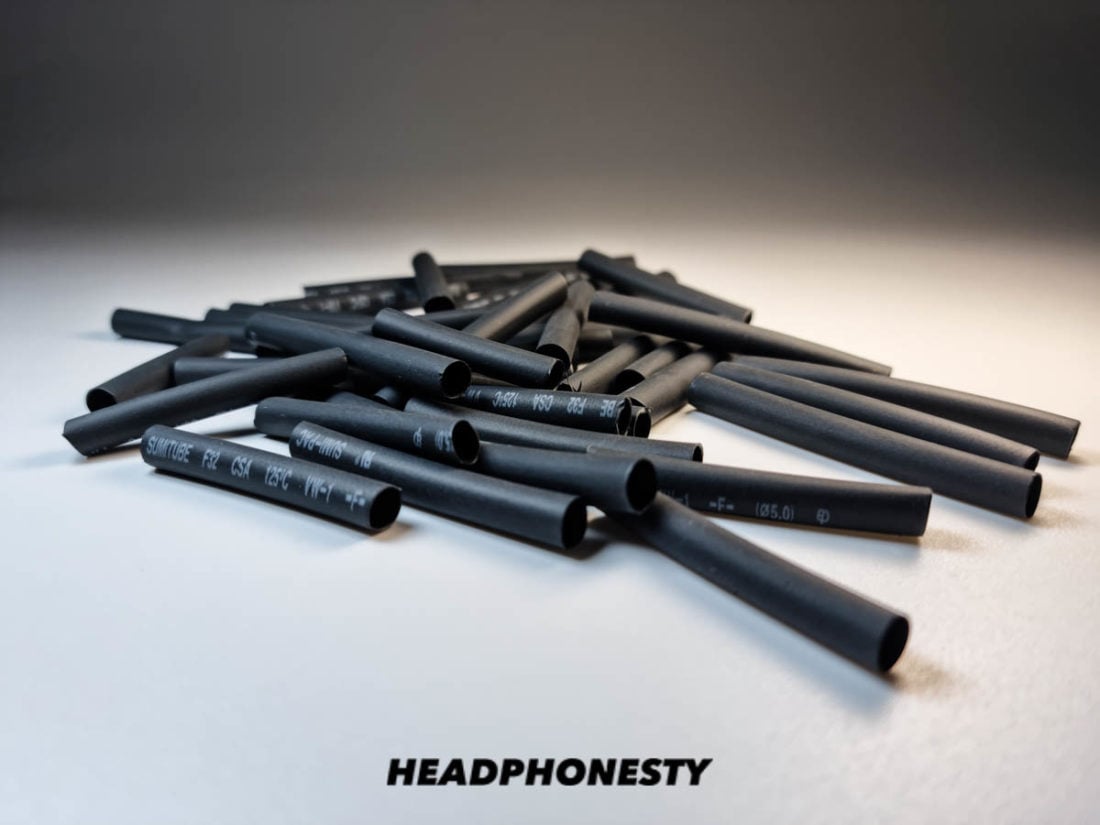
Sugru Mouldable Glue is an all-around moldable adhesive putty made of silicone rubber. You can use this for DIY crafts, mounting needs, electrical repairs, etc. It is moldable, flexible, durable, waterproof, and has good insulation properties.
Here’s how you can use it to repair your frayed headphone wires:
- Clean the wire. Clean the area around the wire with isopropyl alcohol to rid it of excess dust, debris, or oil. Take a clean cloth and pour a small amount of isopropyl alcohol on it. Wipe the area and let it dry.
- Mold it. Sugru Mouldable Glues are soft and malleable like play-dough. Roll the material in your fingers and mold it around the wire using your hands. You have more or less 30 minutes to shape and reposition it as desired before the glue sets.
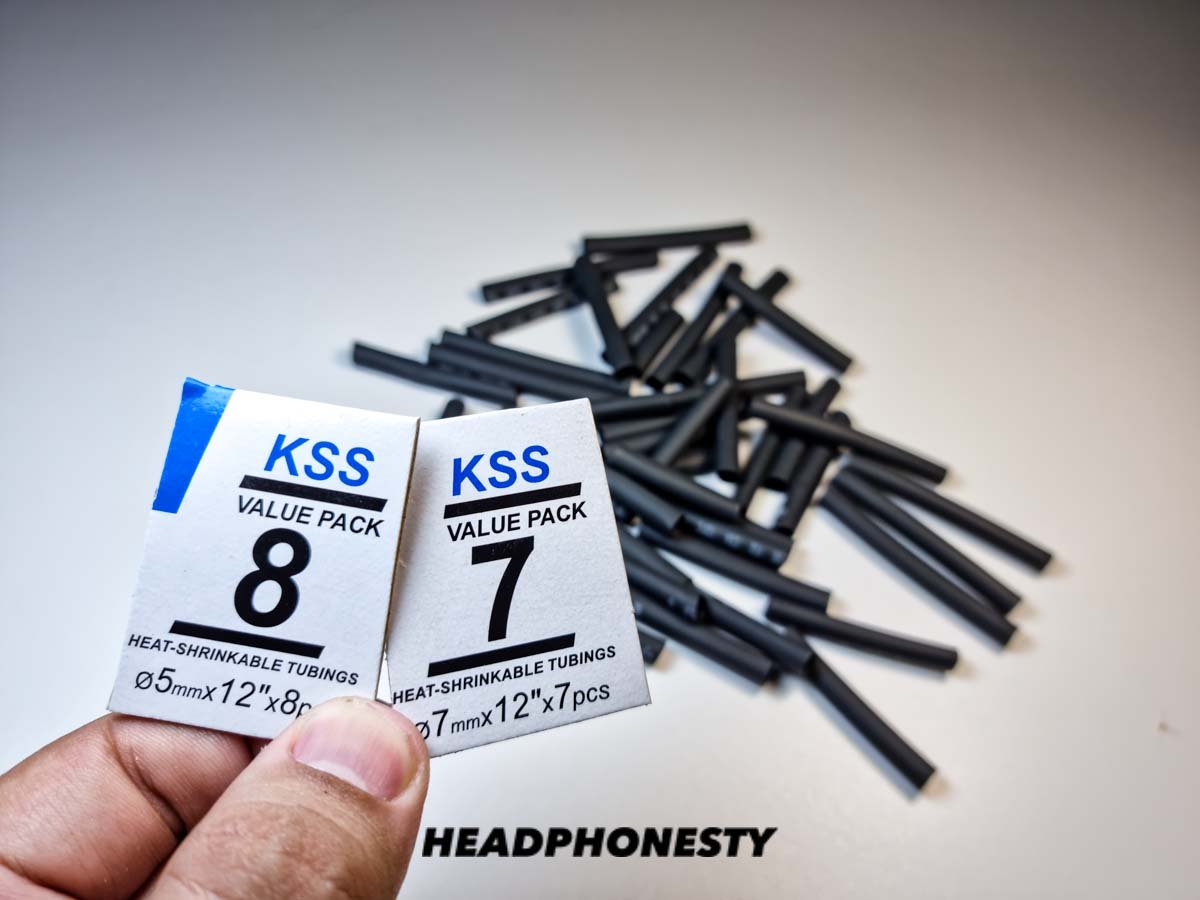
Mold Sugru around the headphone wire - Leave it for 24 hours. Leave the material at room temperature for at least 24 hours to allow it to set permanently.
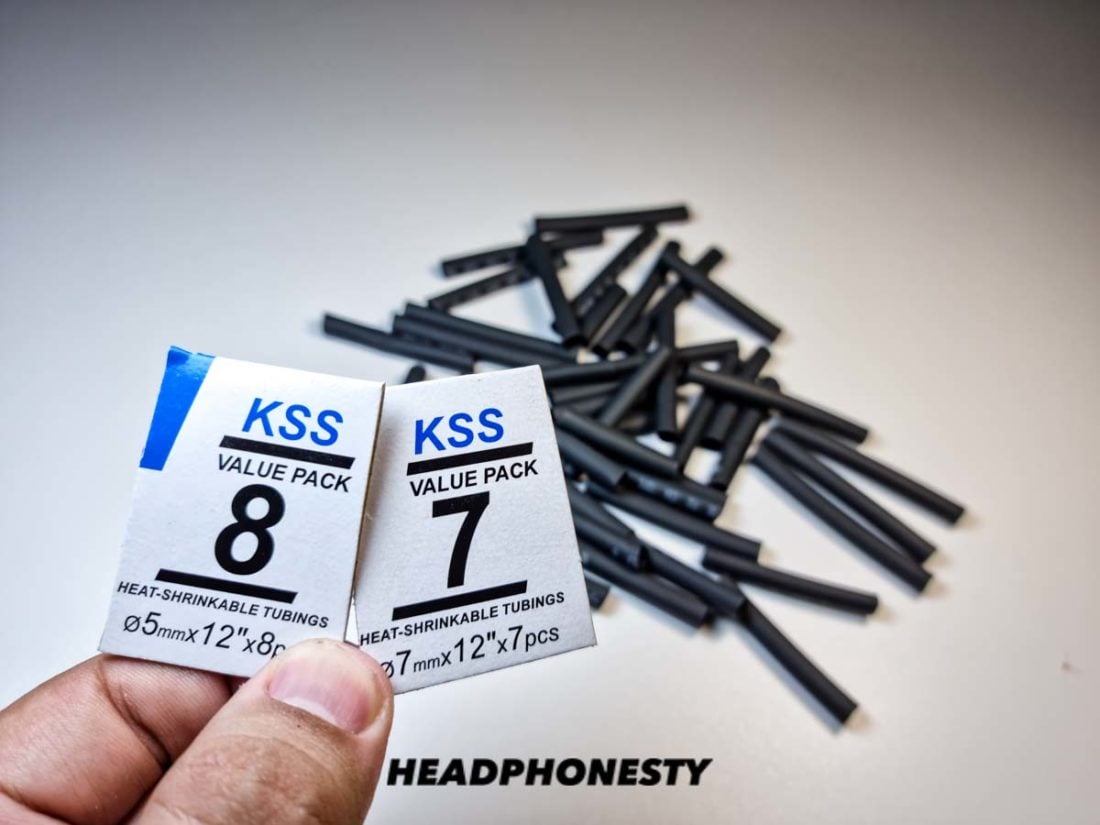
Formed Sugru on wire
Use cable savers
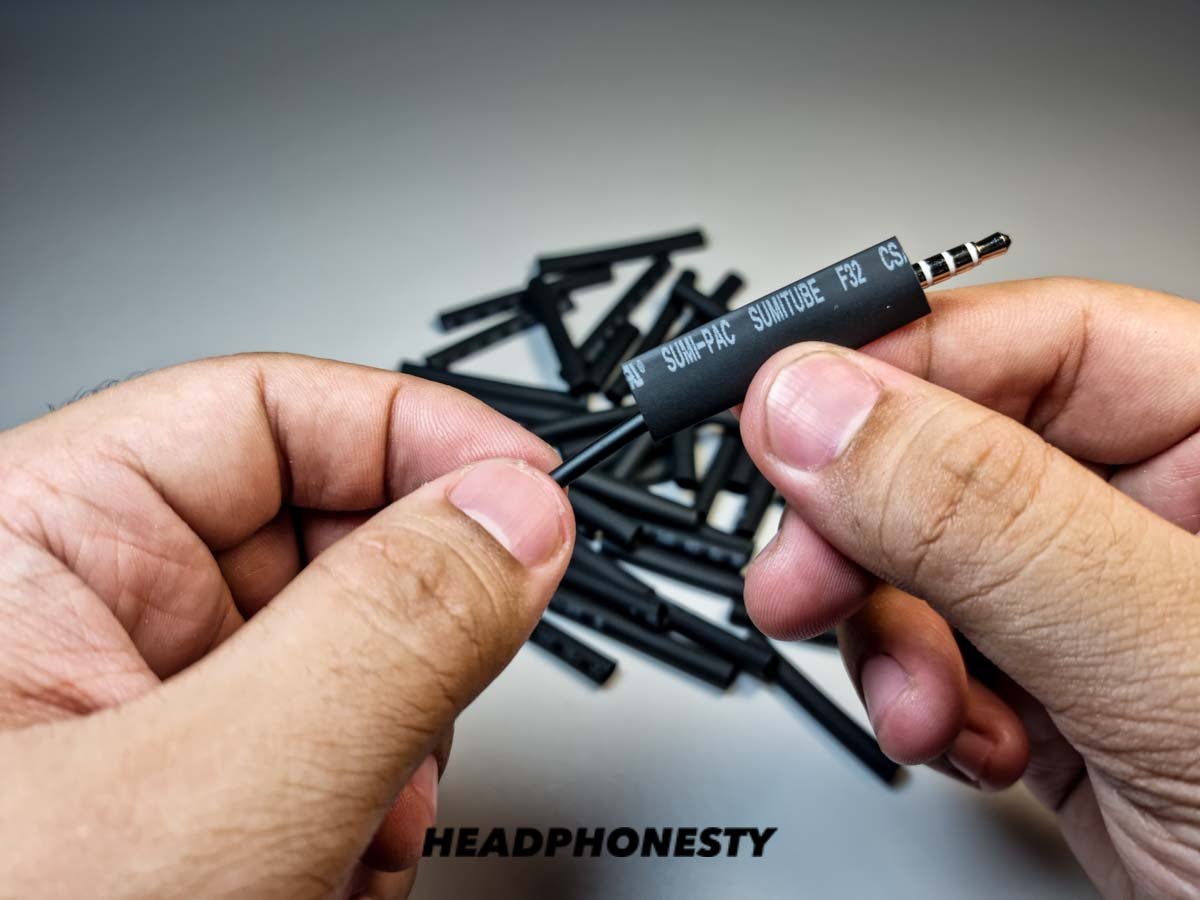
If you’re not much of a DIY person and you want a quick and easy fix, you can try these Jetec cable savers. These are mainly used to prevent wires from fraying. But you can still use them on exposed wires to give your headphone cables added support and backing.
You can use them by following these three easy steps:
- Choose the right cable saver size. These cable savers come in different sizes. Look for the size that would fit your headphone cables the best.
- Wrap. Wrap the cable saver around the part where your headphones’ wire begins to fray.
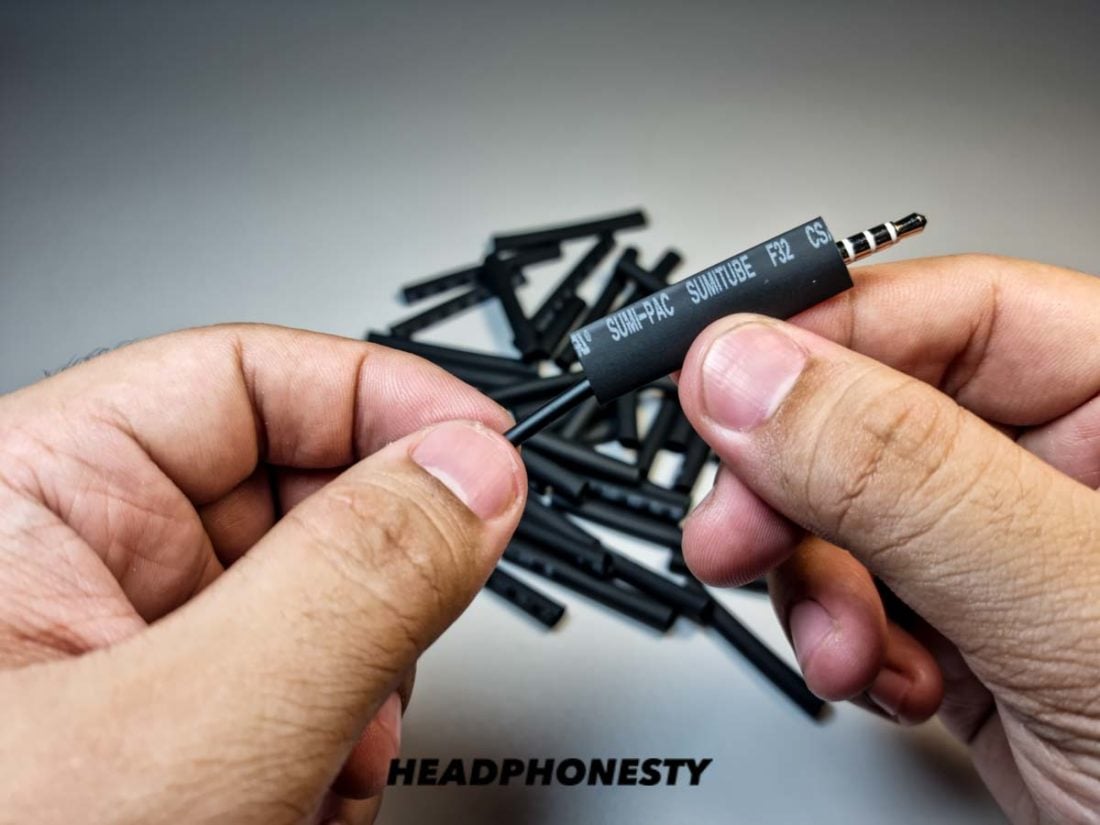
Wrapping the cable saver around the frayed cable (From: Amazon) - Adjust. Make sure to wrap the cable saver up until the very end of the wire (the part where the headphones’ cord meets the plug) so that it stays securely in place.
What to Do With More Severely Damaged Headphone Wires
In cases of more severe damage wherein the wires are completely torn off, there is still hope. The two best ways to approach this involve soldering the headphone wires or using a combination of electrical tape and heat-shrink tubings.
These methods are known to fix many headphone issues, such as hearing static in your headphones or having only one side of your earphones working. However, while these fixes are proven effective most of the time, they still run the risk of not working or causing more damage, especially if the steps aren’t done correctly.
Before you start DIY-ing your damaged headphone wires, a fool-proof and more cost-effective way to approach this is to use the warranty.
If your headphones are still under warranty and the damage is covered, you can defer the repairs to a professional who is sure to know how to fix them properly. This helps you avoid unforeseeable mishaps if you aren’t confident in your DIY skills.
If you decide to DIY your headphones and end up not completely fixing the problem or making it worse, it’s best to buy a new pair of headphones entirely to avoid damaging other devices you use them with. Make sure to follow the necessary protocols on what to do with broken headphones so that you won’t encounter any issues.
But if you are willing to try it, be sure to follow these steps carefully.
Repair with soldering
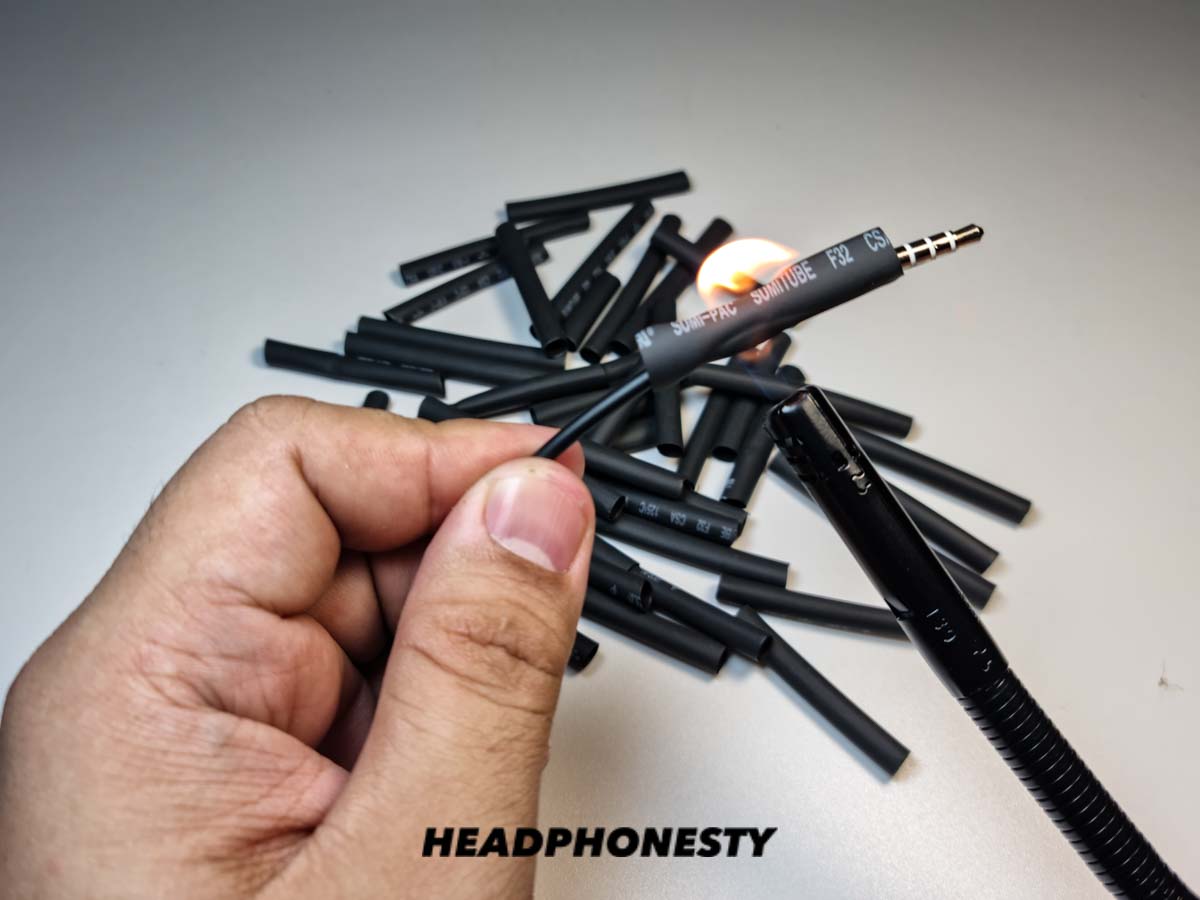
Before you begin, you will need:
- Soldering kit
- Wire stripper/knife/cutter
- Electrical tape / heat-shrink tubing
- Lighter (or sandpaper)
- Start stripping the wire. Strip off the insulation to reveal the wires inside. If you see two wires stuck together, carefully separate the two using a knife or cutter. Remove the outer shielding by slowly running a wire stripper through it (1/4″ to 1/2″ cuts). Continue cutting until you see a broken wire that needs repairing. The inner layer of the headphone cable may reveal differently-colored wires. Generally, the colored wires ( red, green, blue, or copper) transmit sound, and the single bare and uninsulated wire is the ground wire.
- Cut the wire. If the wires inside are shredded and threads are showing, cut the headphone wire. Do this so that they become more uniform and easier to work with.
- Sand the wires to expose the copper. Before soldering, sand off the thin enamel coat on all the wires, including the ground wire. Sand away until the copper is exposed. If you don’t have sandpaper on hand, you can also burn it off using a soldering iron or a lighter.
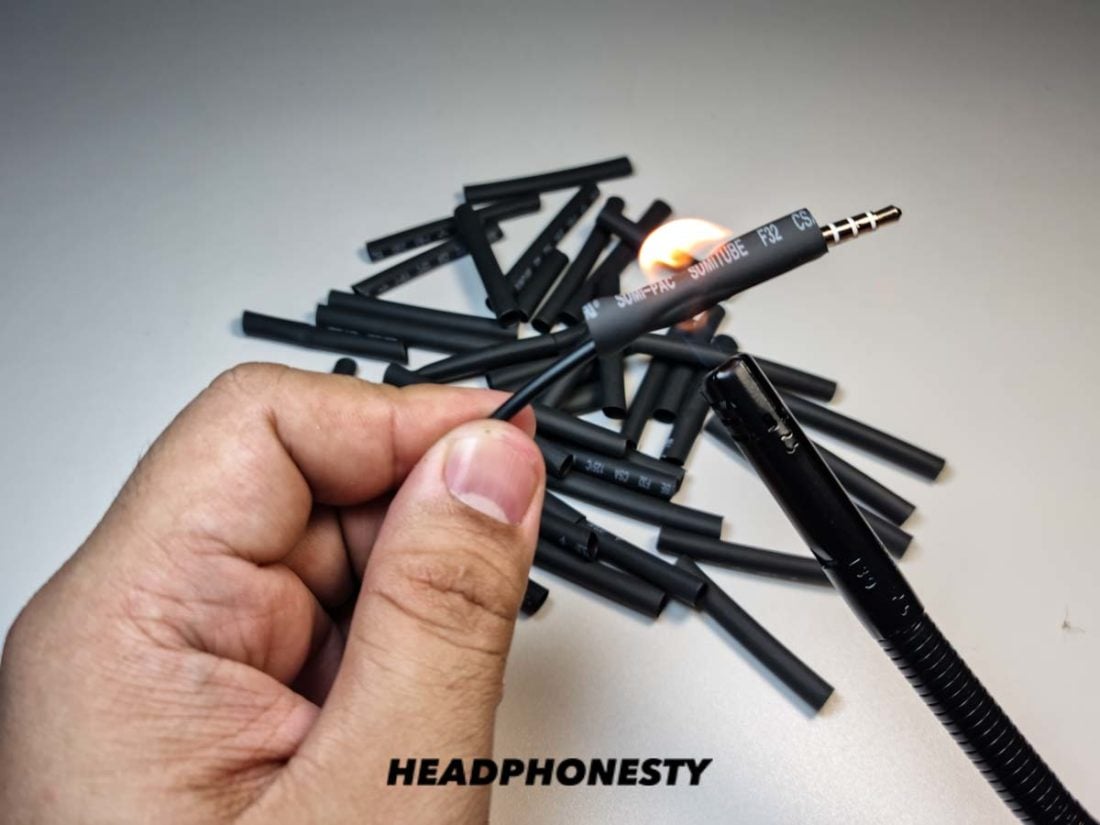
Burning off enamel coating - Twist together and solder. Twist the wires together and solder the connections. Use your soldering iron to melt a thin coat of solder over the wires. Let the wires and solder set and cool completely.
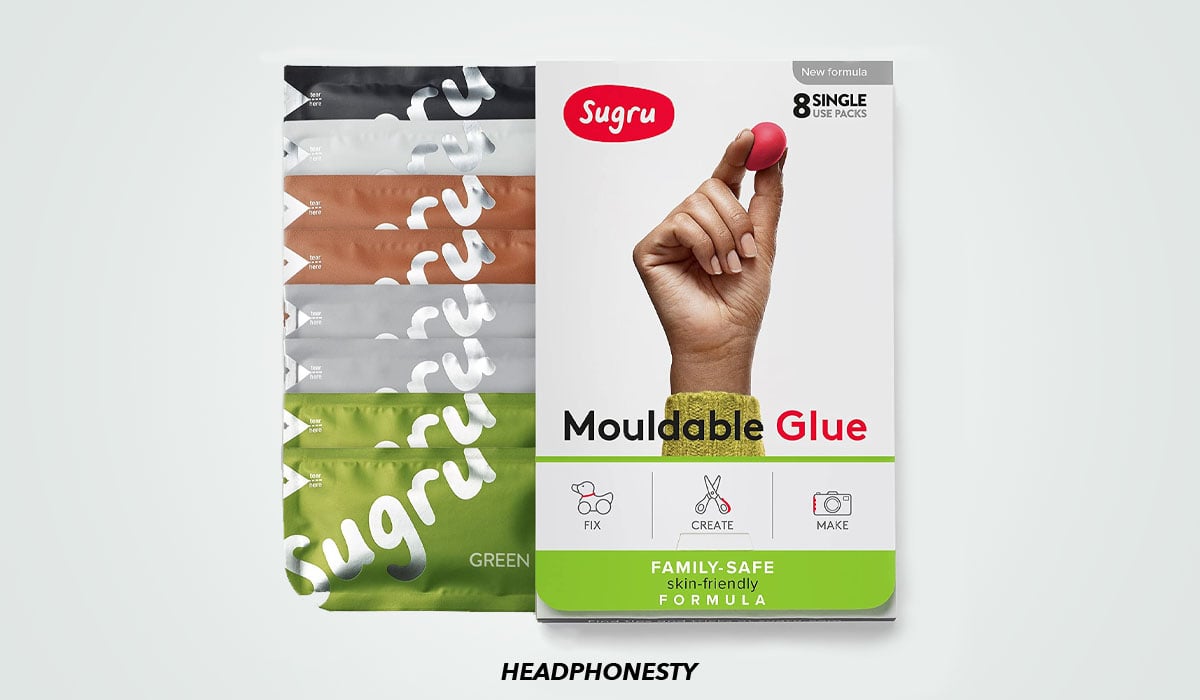
Soldering headphone wire - Wrap each wire carefully with electrical tape. After the internal wires have cooled completely, wrap each wire with electrical tape to keep them from touching each other and avoid any possible short-circuit situation.
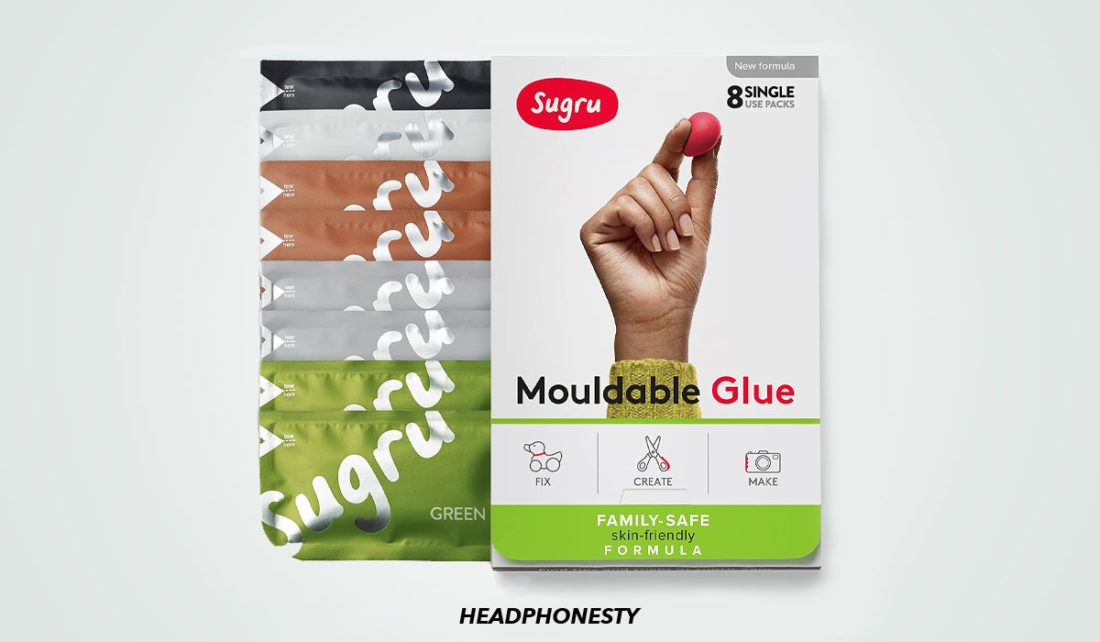
Group wires with electrical tape - Place and heat the heat-shrink tubing securely over the headphone cord. Carefully place the heat-shrink sleeve over your headphone wire, then heat to constrict it. This sleeve will protect and insulate your newly-repaired headphone wire. Alternatively, you may also use electrical tape to wrap the wires if you don’t have heat-shrink tubing on hand.
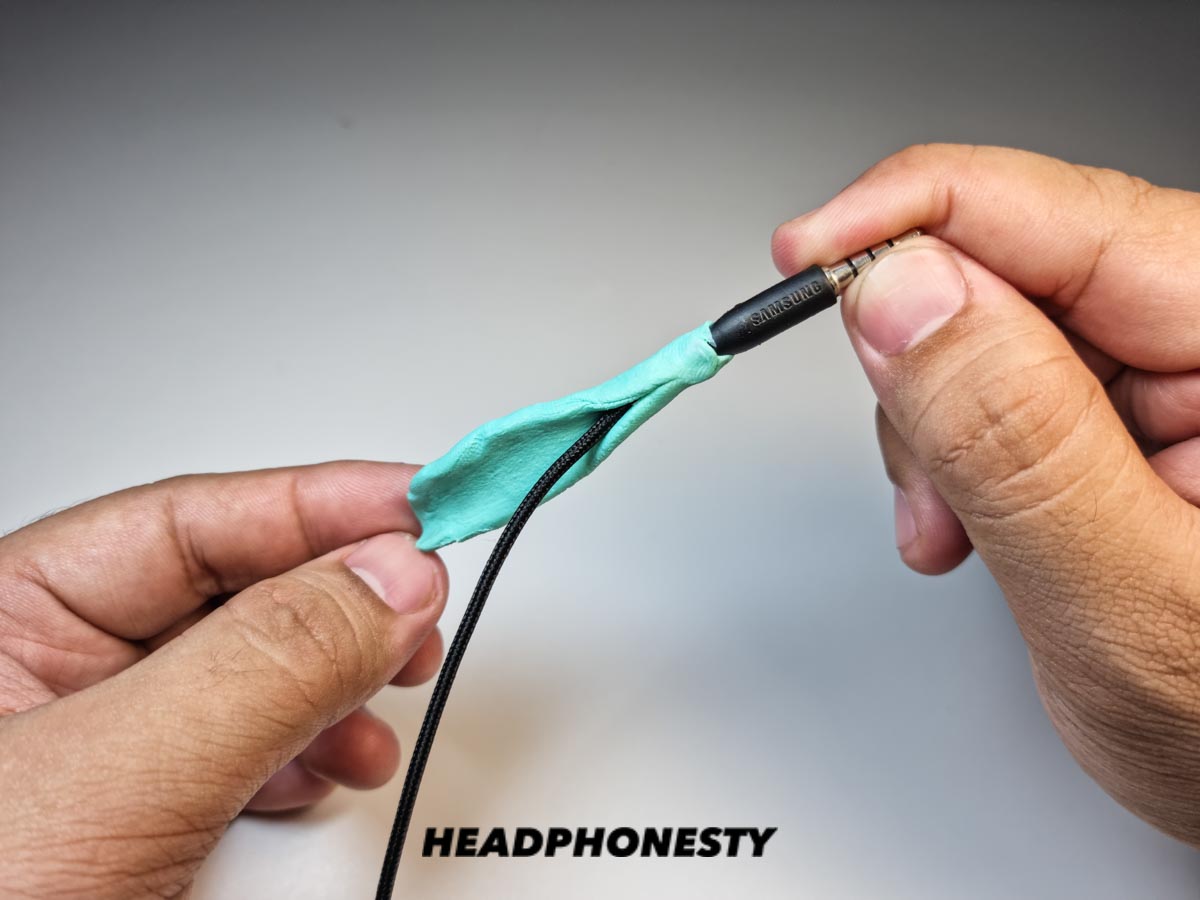
How to fix headphone wires without soldering
If you’re not that handy at soldering, no worries! You can still fix your broken headphone wires using simpler tools.
To repair damaged headphone or earphone wiring without fusing them with a soldering iron, you will need:
- Wire stripper (or cutter)
- Lighter (or sandpaper)
- Electrical tape / heat-shrink tubing
- Scissors
- Remove the rubber covering or sheath. Using a wire stripper (or cutter), remove the rubber covering of the wire to reveal the stripped wires. Be very careful not to cut through any wires.
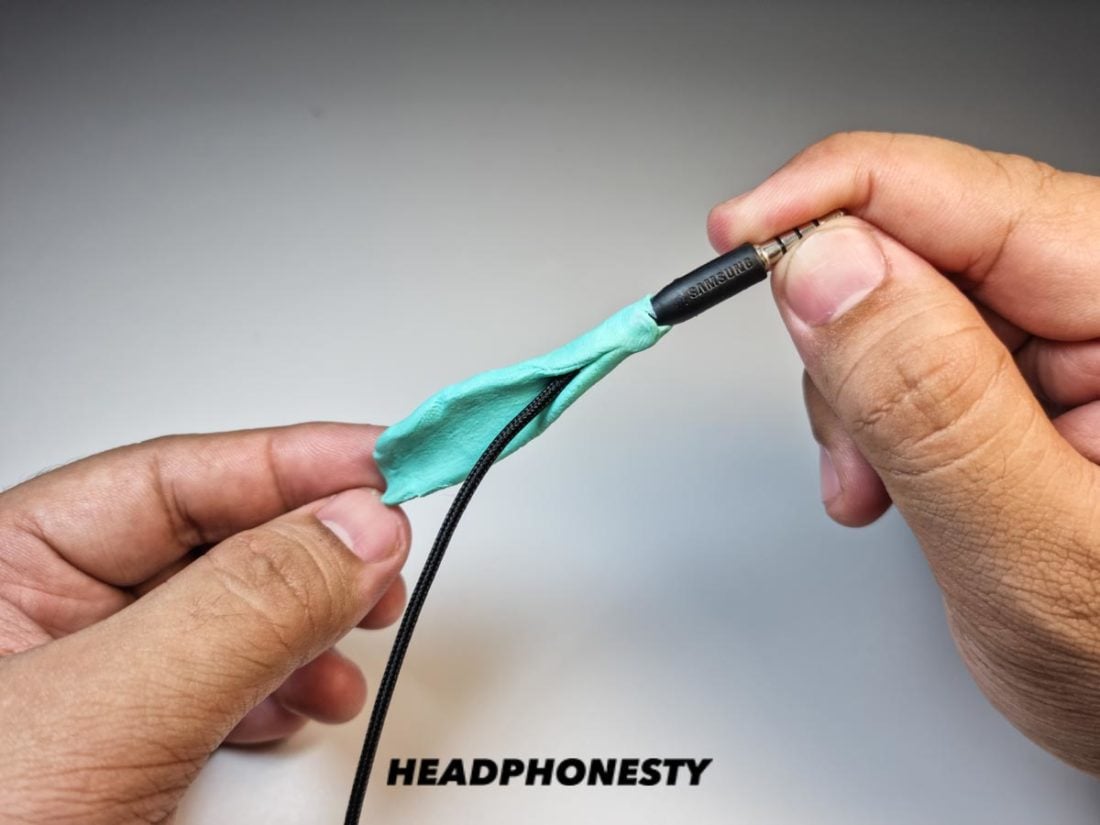
Remove rubber coating - Separate the wires by color. Separate the colored wires (right headphone cable = red wires, left headphone cable = blue/green wires) from the other wires by twisting them together and moving them to the side. Also, do this with the ground wires (copper or gold wires). Repeat the same to the other side of the cable.
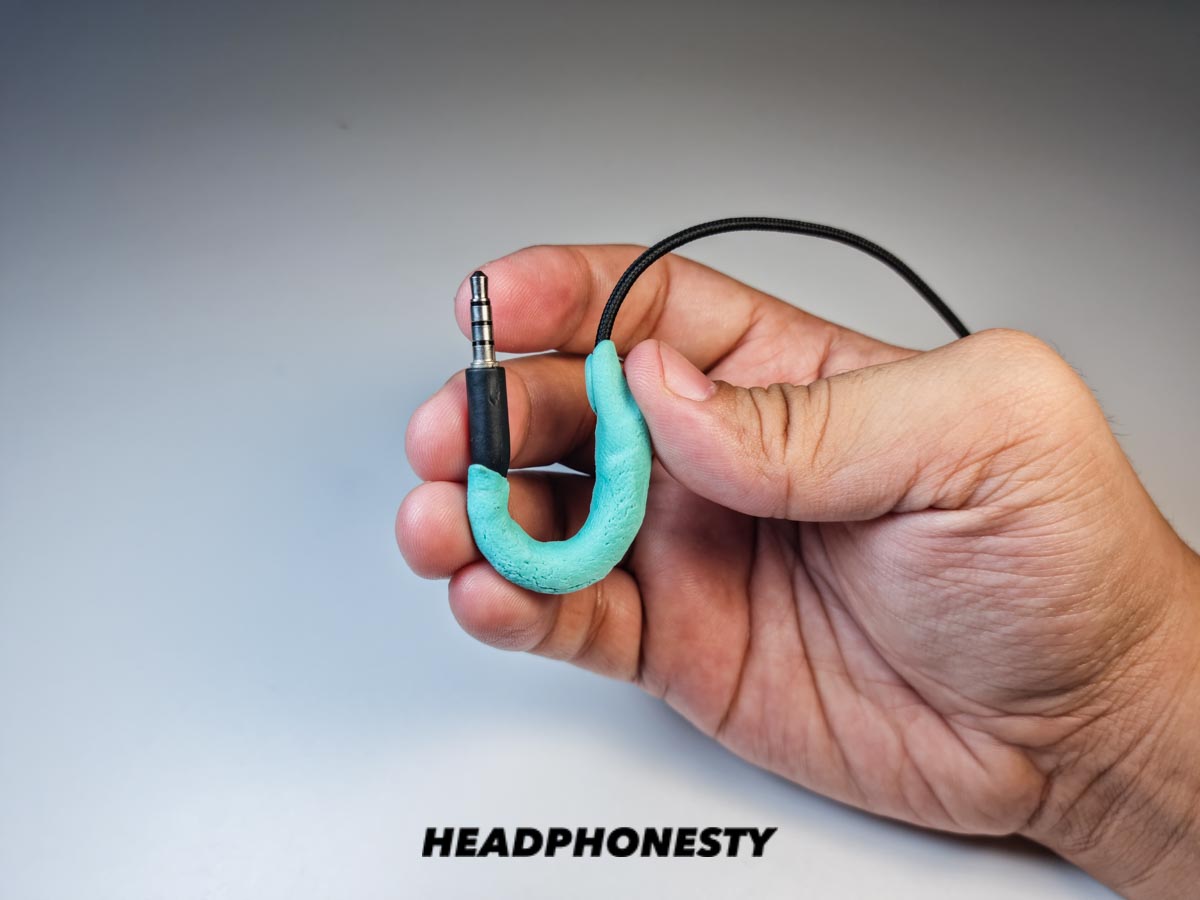
Separate headphone wires by color - Melt off the thin enamel coating. Melt off the enamel coating (colored varnish covering the wires) using a lighter (sandpaper can also work). Repeat the same to the other side of the cable.
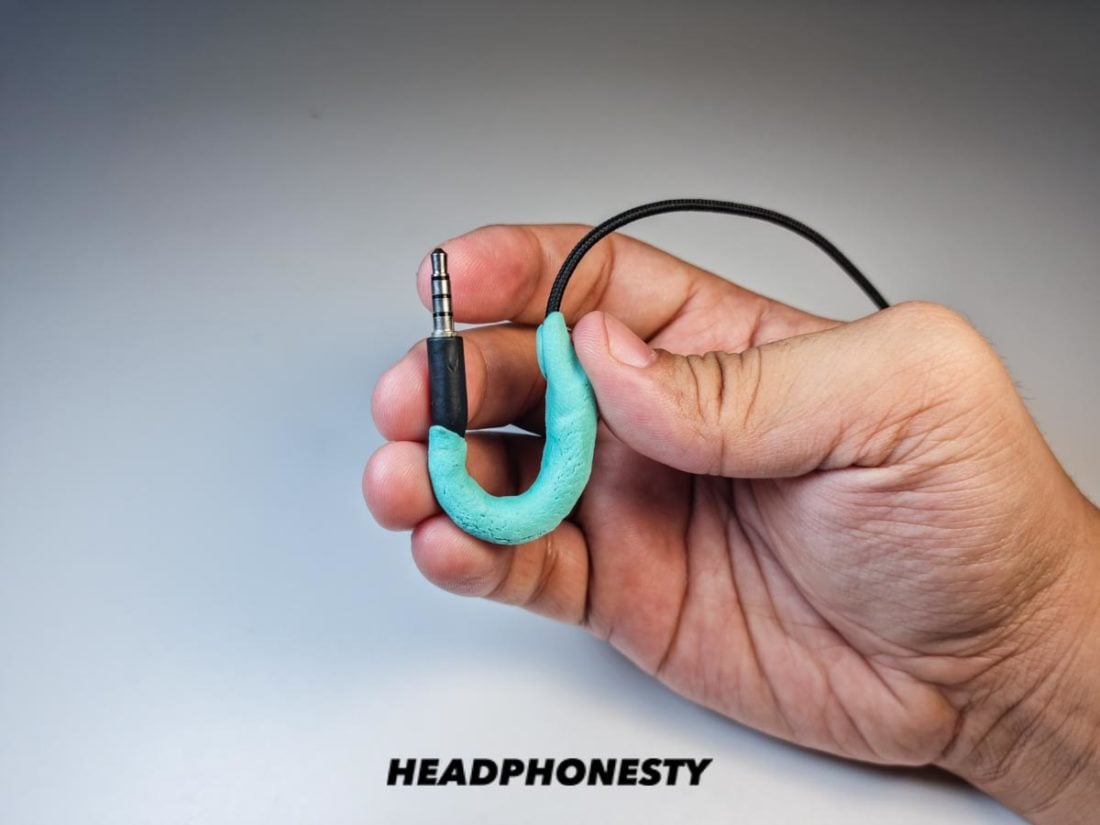
Melting the enamel coating. - Isolate the wirings. Splice the colored wires from either side by twisting them together. Afterward, use electrical tape to isolate the colored wires from the ground wires.
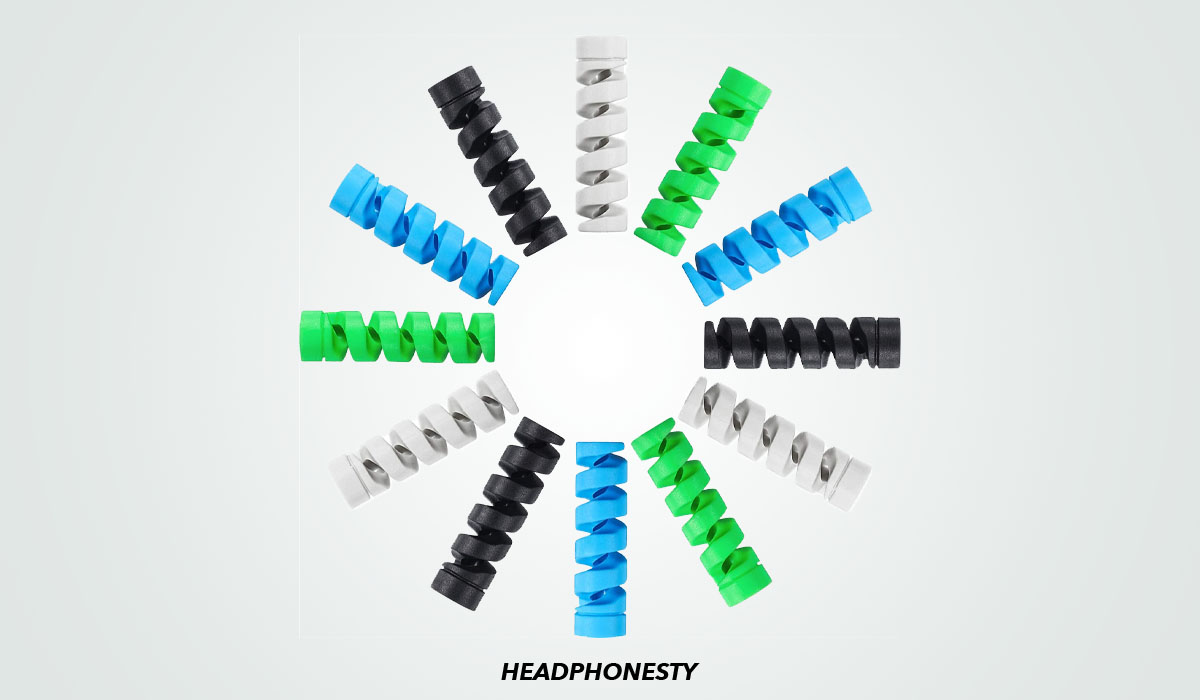
Isolating the wires - Wrap it up. Wrap the wires together by using electrical tape or by using heat-shrink tubing.
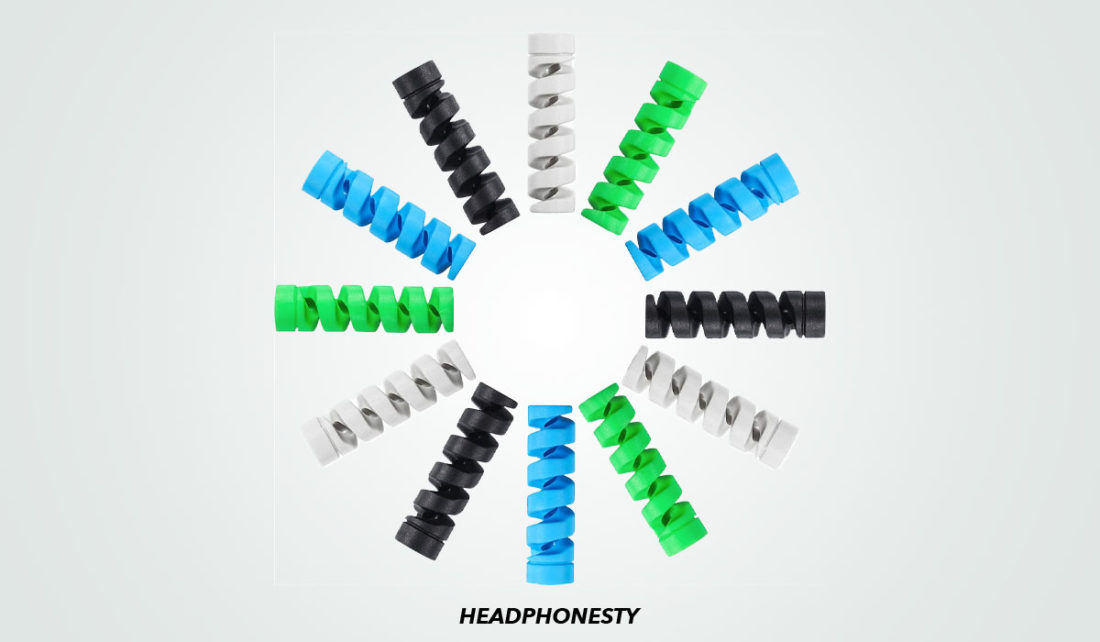
Replacement headphone wires that you can try
If the fixes discussed above aren’t enough to resurrect your broken headphone wires, replacing them may be the wiser choice. We’ve listed a few relatively affordable replacement options in the section below.
But if you’re thinking of buying more high-end cables, see if it’s worth it by going through our in-depth guide on expensive headphone cables.
If you’re okay with inexpensive cables, feel free to go through our recommendations for replacement headphone wires:
LANMU replacement cable
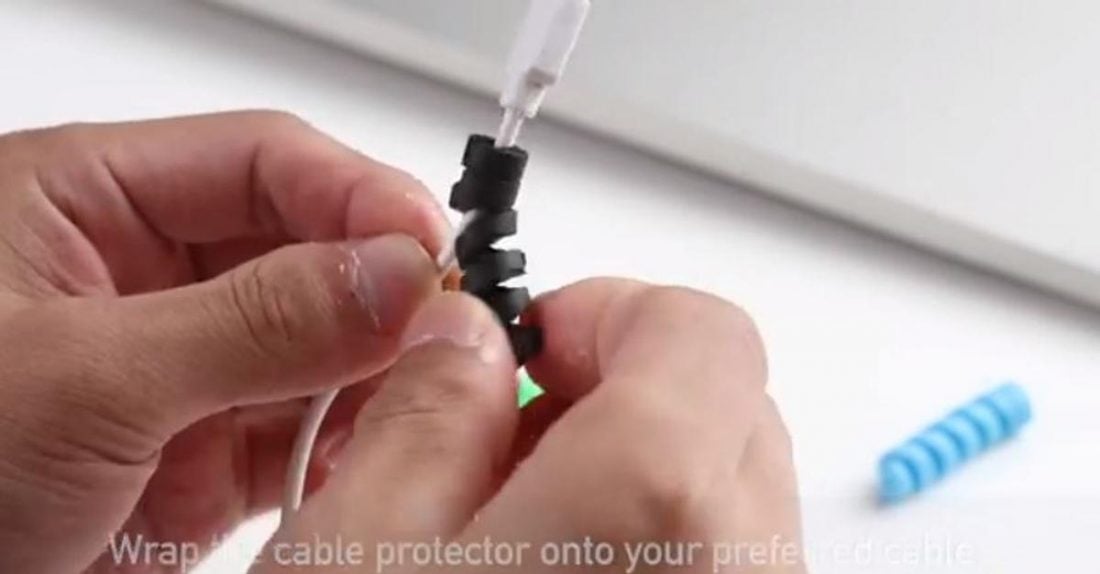
These LANMU Replacement Cables are made of high-quality transparent PVC. The wires are not easy to knot, so they remain intact even with everyday use. Their durable structural support also gives them good tensile strength.
Earla Tec replacement audio cable cord wire with in-line mic and control
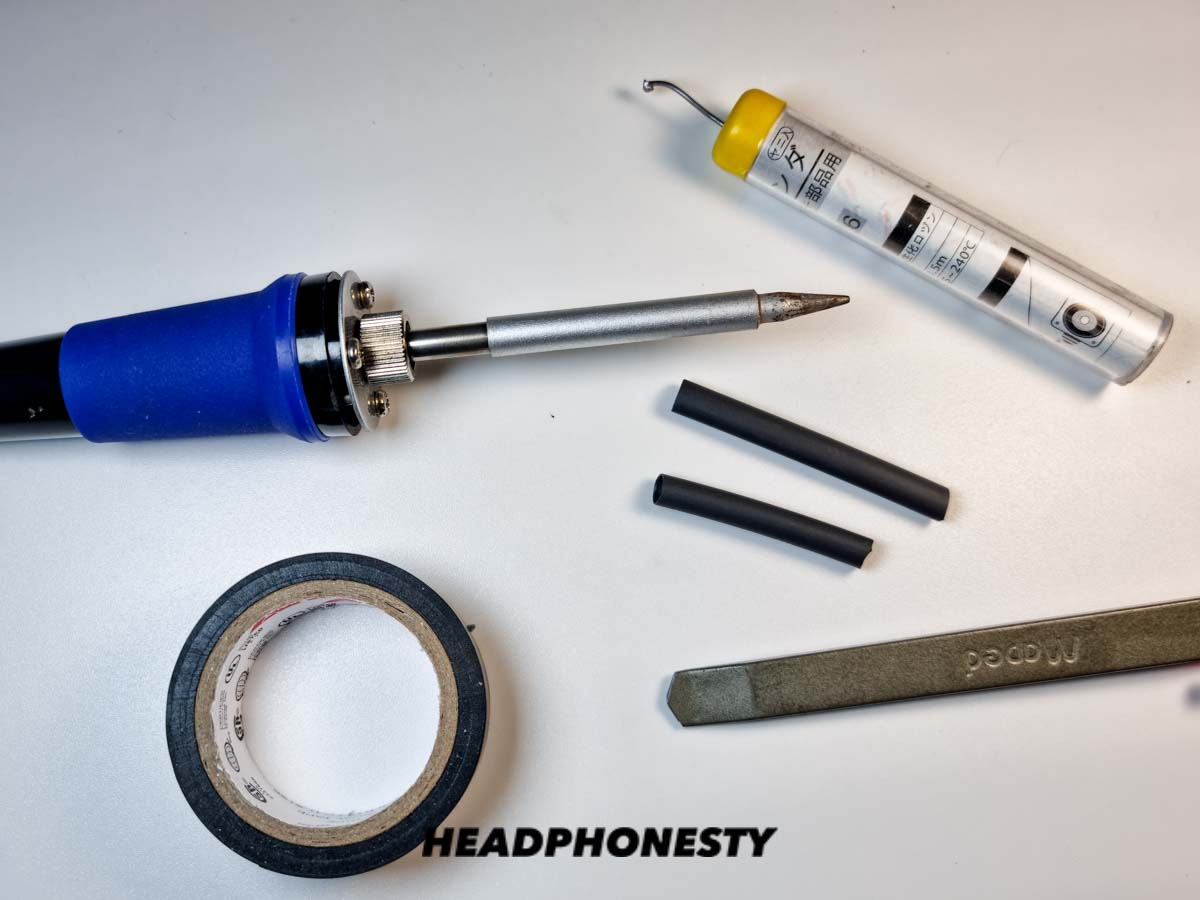
This Earla Tec Replacement Cable is compatible with Beats Studio, Executive, Mixer, and Apple iPhones. The cable material is TPU-coated, soft, tangle-free, and durable. This is a good choice for those looking for a replacement cable with an in-line microphone and control setting.
Fancasee 2-pack replacement cord (wire open end)
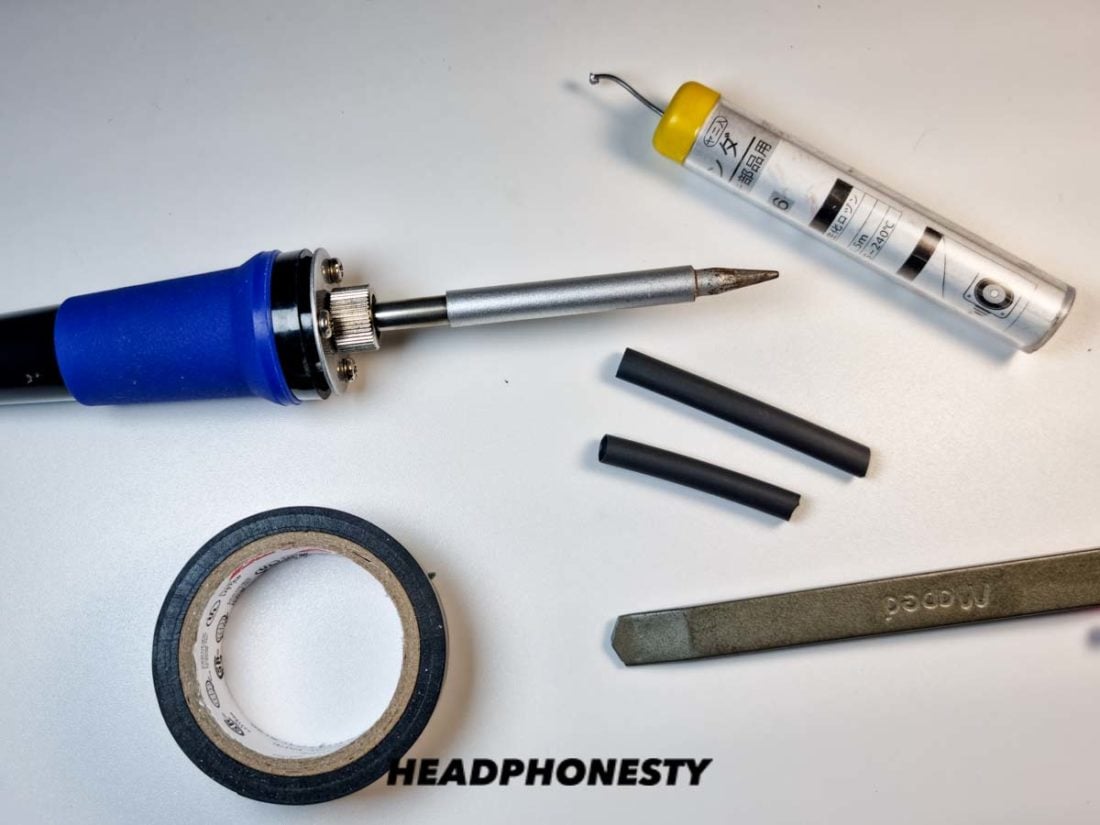
This Fancasee 2-pack Replacement Cord is the perfect replacement for lost or worn-out headphone wires with a 3.5mm male plug connector. It is easy to install. Just connect the respective bare wires and wrap them together. Finally, secure the bare wire using electrical tape or heat-shrink tubing.
Conclusion
Not all broken headphones warrant immediate replacement or disposal. Sometimes, with a bit of patience and resourcefulness, a little DIY repair can fix problems from frayed wires to damaged headphone pads.
That being said, we hope this article has helped you find new ways to salvage your beloved headphones or earphones. If your headphones are experiencing any other problems, feel free to check out our ultimate guide to fixing broken headphones.
If you’ve successfully ‘saved’ your headphone wires using any of the tips above, we’d love to hear about it in the comments section below. Also, if you have any other tips and tricks that you swear by, do share them with us too!



![How to fix error 0xc000000e windows 10 2022 100 SOLVED 53 How to fix error 0xc000000e windows 10 2022: [100% SOLVED]](https://dreamcheeky.com/wp-content/uploads/2022/06/How-to-fix-error-0xc000000e-windows-10-2022-100-SOLVED.jpg)
![how to fix Error code 0xc0000001 2022 100 FIXED 54 how to fix Error code 0xc0000001 2022 :[100% FIXED]](https://dreamcheeky.com/wp-content/uploads/2022/06/how-to-fix-Error-code-0xc0000001-2022-100-FIXED.jpg)